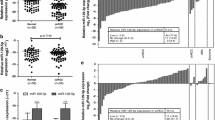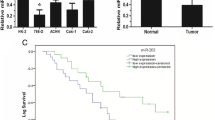Abstract
Renal cell carcinoma (RCC) is the most common neoplasm of adult kidney accounting for about 3 % of adult malignancies. MicroRNAs (miRNAs) are a class of naturally occurring, short non-coding RNAs that regulate gene expression at the post-transcriptional level. We determined global miRNA expression profiles of RCC and parallel renal parenchyma tissues by using quantitative reverse transcriptase-polymerase chain reaction-based TaqMan low-density arrays. Afterward, we validated the difference in miR-210 expression levels on the larger group of RCC patients (35 RCC versus 10 non-tumorous parenchyma samples). Functional in vitro experiments were performed on ACHN and CAKI-2 RCC cell lines transfected with miRNA-210 inhibitor. Cell viability, apoptosis, cell cycle, scratch wound migration assay, and invasion assay (xCELLigence) were performed. We have identified original ccRCC-specific miRNA signature in clinical samples (73 miRNAs were significantly downregulated and five miRNAs upregulated (P < 0.003)). Increased expression levels of miR-210 in RCC tumor tissue were independently validated. We observed decreased viability of ACHN and CAKI-2 cells and accumulation of CAKI-2 in G2 phase of cell cycle after silencing of miR-210 expression. Downregulation of miR-210 also reduced the migratory and invasive potential of ACHN metastatic RCC cells. Moreover, we showed downregulation of HIF1a protein in both cell lines after miR-210 silencing indicating participation of miR-210 in hypoxic processes of RCC not only through regulation of its target mRNAs but also by indirect regulation of HIF1a. To our knowledge, this is the first report to show miR-210 regulatory effects on cell migration, invasive potential, and HIF1a protein in RCC cells.




Similar content being viewed by others
References
Campbell SC, Novick AC, Bukowski RM. Renal tumors. In: Wein AJ, Kavoussi LR, Novick AC, et al., editors. Campbell-Wals Urology. 9th ed. Philadelphia: Saunders; 2007. p. 1567–637.
Croce CM. Causes and consequences of microRNA dysregulation in cancer. Nat Rev Genet. 2009;10:704–14.
Carthew RW, Sontheimer EJ. Origins and mechanisms of miRNAs and siRNAs. Cell. 2009;136:642–55.
Winter J, Diederichs S. MicroRNA biogenesis and cancer. Methods Mol Biol. 2011;676:3–22.
Chow TF, Youssef YM, Lianidou E, Romaschin AD, Honey RJ, Stewart R, et al. Differential expression profiling of microRNAs and their potential involvement in renal cell carcinoma pathogenesis. Clin Biochem. 2010;43:150–8.
Nakada C, Matsuura K, Tsukamoto Y, Tanigawa M, Yoshimoto T, Narimatsu T, et al. Genome-wide microRNA expression profiling in renal cell carcinoma: significant down-regulation of miR-141 and miR-200c. J Pathol. 2008;216:418–27.
Slaby O, Jancovicova J, Lakomy R, Svoboda M, Poprach A, Fabian P, et al. Expression of miRNA-106b in conventional renal cell carcinoma is a potential marker for prediction of early metastasis after nephrectomy. J Exp Clin Cancer Res. 2010;29:90.
Giannakakis A, Sandaltzopoulos R, Greshock J, Liang S, Huang J, Hasegawa K, et al. MiR-210 links hypoxia with cell cycle regulation and is deleted in human epithelial ovarian cancer. Cancer Biol Ther. 2008;7:255–64.
White NM, Yousef GM. MicroRNAs: exploring a new dimension in the pathogenesis of kidney cancer. BMC Med. 2010;8:65.
Reimers M, Carey VJ. Bioconductor: an open source framework for bioinformatics and computational biology. Methods Enzymol. 2006;411:119–34.
Slaby O, Svoboda M, Michalek J, Vyzula R. MicroRNAs in colorectal cancer: translation of molecular biology into clinical application. Mol Cancer. 2009;8:102.
Redova M, Svoboda M, Slaby O. MicroRNAs and their target gene networks in renal cell carcinoma. Biochem Biophys Res Commun. 2011;405:153–6.
Chen Y, Stallings RL. Differential patterns of microRNA expression in neuroblastoma are correlated with prognosis, differentiation, and apoptosis. Cancer Res. 2007;67:976–83.
Zhou L, Chen J, Li Z, Li X, Hu X, Huang Y, et al. Integrated profiling of microRNAs and mRNAs: microRNAs located on Xq27.3 associate with clear cell renal cell carcinoma. PLoS One. 2010;5:e15224.
Heinzelmann J, Henning B, Sanjmyatav J, Posorski N, Steiner T, Wunderlich H, et al. Specific miRNA signatures are associated with metastasis and poor prognosis in clear cell renal cell carcinoma. World Urol. 2011;29:367–73.
Song KH, Li T, Owsley E, Chiang JY. A putative role of micro RNA in regulation of cholesterol 7alpha-hydroxylase expression in human hepatocytes. J Lipid Res. 2010;51:2223–33.
Xu Y, Xia F, Ma L, Shan J, Shen J, Yang Z, et al. MicroRNA-122 sensitizes HCC cancer cells to adriamycin and vincristine through modulating expression of MDR and inducing cell cycle arrest. Cancer Lett. 2011;310:160–9.
Gui J, Tian Y, Wen X, Zhang W, Zhang P, Gao J. Serum microRNA characterization identifies miR-885-5p as a potential marker for detecting liver pathologies. Clin Sci (Lond). 2011;120:183–93.
Garzon R, Pichiorri F, Palumbo T, Visentini M, Aqeilan R, Cimmino A, et al. MicroRNA gene expression during retinoic acid-induced differentiation of human acute promyelocytic leukemia. Oncogene. 2007;26:4148–57.
Lowery AJ, Miller N, Devaney A, McNeill RE, Davoren PA, Lemetre C, et al. MicroRNA signatures predict oestrogen receptor, progesterone receptor and HER2/neu receptor status in breast cancer. Breast Cancer Res. 2009;11:R27.
Huang Y, Dai Y, Yang J, Chen T, Yin Y, Tang M, et al. Microarray analysis of microRNA expression in renal clear cell carcinoma. Eur J Surg Oncol. 2009;35:1119–23.
Seliger B, Jasinski S, Dressler SP, Marincola FM, Recktenwald CV, Wang E, Lichtenfels R. Linkage of microRNA and proteome-based profiling data sets: a perspective for the priorization of candidate biomarkers in renal cell carcinoma? J Proteome Res. 2011;10:191–9.
White NM, Bao TT, Grigull J, Youssef YM, Girgis A, Diamandis M, et al. miRNA profiling for clear cell renal cell carcinoma: biomarker discovery and identification of potential controls and consequences of miRNA dysregulation. J Urol. 2011;186:1077–83.
Valera VA, Walter BA, Linehan WM, Merino MJ. Regulatory effects of microRNA-92 (miR-92) on VHL gene expression and the hypoxic activation of miR-210 in clear cell renal cell carcinoma. J Cancer. 2011;2:515–26.
Chan SY, Loscalzo J. MicroRNA-210: a unique and pleiotropic hypoxamir. Cell Cycle. 2011;9:1072–83.
Nakada C, Tsukamoto Y, Matsuura K, Nguyen TL, Hijiya N, Uchida T, et al. Overexpression of miR-210, a downstream target of HIF1α, causes centrosome amplification in renal carcinoma cells. J Pathol. 2011;224:280–8.
Rothé F, Ignatiadis M, Chaboteaux C, Haibe-Kains B, Kheddoumi N, Majjaj S, et al. Global microRNA expression profiling identifies MiR-210 associated with tumor proliferation, invasion and poor clinical outcome in breast cancer. PLoS One. 2011;6:e20980.
Zhang Z, Sun H, Dai H, Walsh RM, Imakura M, Schelter J, et al. MicroRNA miR-210 modulates cellular response to hypoxia through the MYC antagonist MNT. Cell Cycle. 2009;8:2756–68.
Fasanaro P, D’Alessandra Y, Di Stefano V, Melchionna R, Romani S, Pompilio G. MicroRNA-210 modulates endothelial cell response to hypoxia and inhibits the receptor tyrosine kinase ligand ephrin-A3. J Biol Chem. 2008;283:15878–83.
Kelly TJ, Souza AL, Clish CB, Puigserver P. A hypoxia-induced positive feedback loop promotes hypoxia-inducible factor 1alpha stability through miR-210 suppression of glycerol-3-phosphate dehydrogenase 1-like. Mol Cell Biol. 2011;31:2696–706.
Acknowledgment
This work was supported by grant IGA NT/13547 of the Czech Ministry of Health, by Institutional Resources for Supporting the Research Organization provided by the Czech Ministry of Health in 2012 to Masaryk Memorial Cancer Institute, by The Ministry of Education, Youth and Sports for the project BBMRI CZ (LM2010004), and by the project “CEITEC–Central European Institute of Technology” (CZ.1.05/1.1.00/02.0068).
Conflicts of interest
None.
Author information
Authors and Affiliations
Corresponding author
Additional information
Martina Redova and Alexandr Poprach contributed equally to this work.
About this article
Cite this article
Redova, M., Poprach, A., Besse, A. et al. MiR-210 expression in tumor tissue and in vitro effects of its silencing in renal cell carcinoma. Tumor Biol. 34, 481–491 (2013). https://doi.org/10.1007/s13277-012-0573-2
Received:
Accepted:
Published:
Issue Date:
DOI: https://doi.org/10.1007/s13277-012-0573-2




